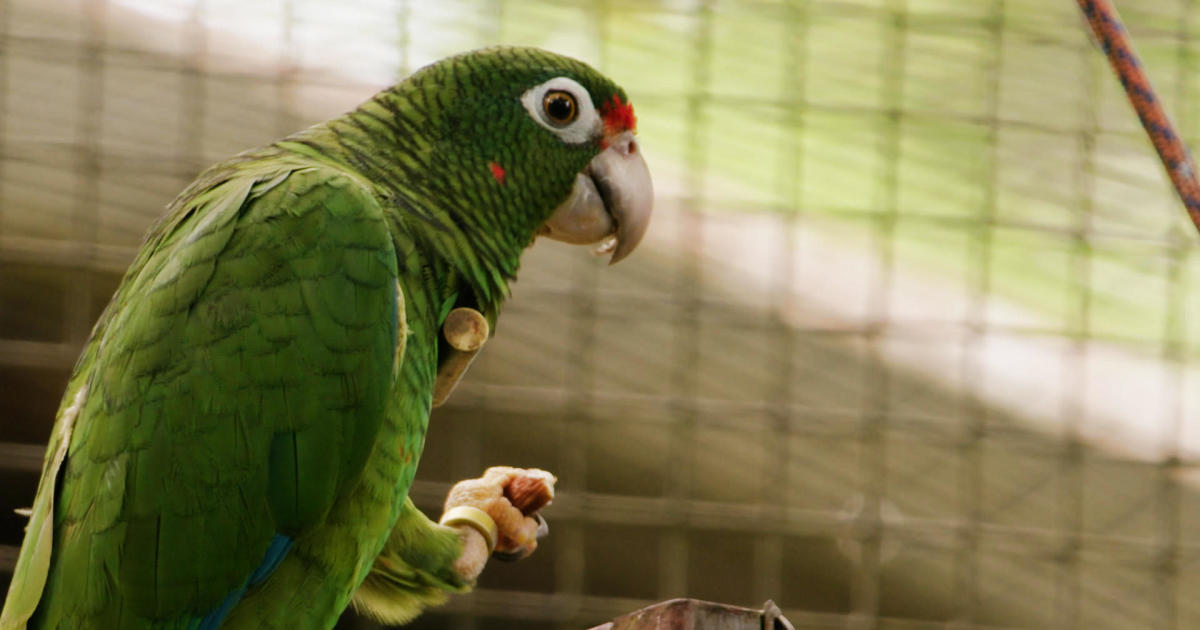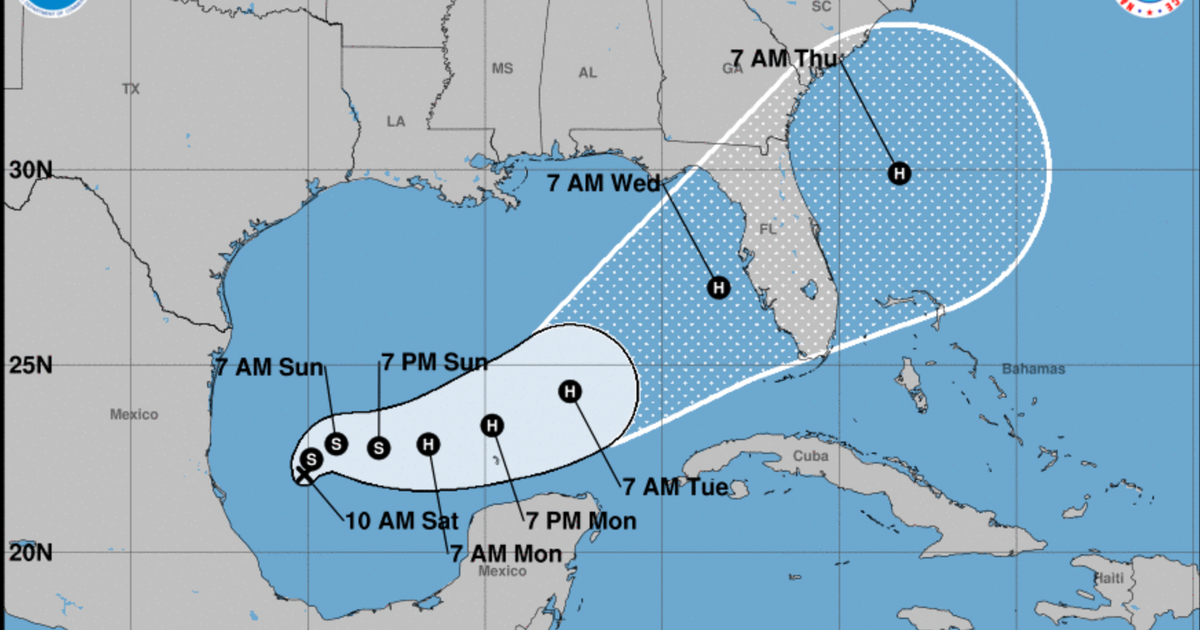CBS News
Puerto Rican parrot threatened by more intense, climate-driven hurricanes

There were 56 wild, endangered Puerto Rican parrots living around El Yunque National Forest before Hurricane Maria in 2017. After the storm, there was only one survivor.
“I’ll admit that a couple of times I just cried,” said Tom White, a biologist with the U.S. Fish and Wildlife Service, who’s been working for 30 years to re-establish a wild Puerto Rican parrot population at El Yunque.
The parrot is one of the most critically endangered birds in the world, according to the International Union for Conservation of Nature and Natural Resources.
About 60 years ago, the U.S. Fish and Wildlife Service listed the parrot as an endangered species, a legal status that has resulted in a continuous and challenging effort to rebuild a healthy population of birds in the wild that continues today.
“If human beings have caused it, it is basically incumbent upon us to fix it,” White said.
Jose Sanchez / CBS News
But the Puerto Rican parrot is also one of the many species whose habitat and survival is threatened by hurricanes, which are becoming more and more destructive due to climate change.
Hurricane Maria killed almost 3,000 people, causing historic floods and landslides. Researchers found Maria’s extreme rainfall was 5 times more likely because of climate change.
Battered by 175 mph wind speeds, White and his wife rode out the storm inside a hurricane shelter with 120 captive, breeding pairs of parrots, protecting them from the storm. Afterwards, they went outside to survey the damage.
“We were speechless,” he said. “It went from being green and lush to brown and defoliated in a question of hours.”
All the captive birds White had in the hurricane shelter survived the storm. But because of heavy debris, crews could not reach the 56 wild birds that had previously been released and were living in remote areas of the forest.
While some of those wild parrots were killed by hurricane winds, many more died of starvation after the storm, with the island’s forests stripped bare of vegetation.
“There was nothing for them to eat,” said Marisel López Flores, leader of the Parrot Recovery Program.
Birds in crisis
Around the world, birds are in crisis — and not just exotic ones. Over the last 400 years, nine bird species in North America have gone extinct, according to the National Audubon Society. Within this century, the group estimates 314 species are threatened with extinction.
Some of the largest declines, according to a landmark study from the Cornell Lab of Ornithology, are happening in the most common types of birds. The study looked at population decline between 1970 and 2019 and found major losses of:
-
Wood thrushes, found across the eastern U.S.; 60% of them are gone.
-
Baltimore orioles, also an eastern bird; two-fifths have been lost.
-
Western meadowlarks, prevalent in the central and western U.S.; three-fourths have disappeared.
Some of the major threats to birds come from habitat loss and global temperature rise. But more intense hurricanes also play a role.
While many birds are adapted to survive major storms, they may struggle to overcome damage to their habitats that are needed to nest, forage and roost — which is what happened to many Puerto Rican parrots.
White explained that protecting the habitats of the parrots can also protect the habitats of thousands of other species.
“By doing so, you protect the world for many others at the same time,” he said.
Giving the birds a better chance
Since Hurricane Maria, the U.S. Fish and Wildlife Service is successfully reestablishing a wild population of parrots, now with a new twist.
Before the hurricane, the birds were released into remote corners of El Yunque. Now, scientists and staff use behavioral techniques that encourage the birds to stay close to the aviary complex.
Essentially, this combines wild and captive birds into a single community at the aviary. In future disasters, this may give the birds a better chance of being rescued and fed when the forest is impassable.
Biologists developed this technique at a sister parrot aviary in Puerto Rico, at Rio Abajo State Forest, where, after Maria, they were able to feed 90 birds and save their lives. The techniques developed in Puerto Rico have since also been successfully used in the release of endangered macaws in Brazil.
Tom White, the U.S. Fish and Wildlife biologist, said birds survive better with larger flock sizes.
“Flocks defend against predators and also to better find food resources,” White said.
In January, the aviary in El Yunque released 22 birds from captivity. Between three aviary locations across Puerto Rico, today there are about 300 parrots living in the wild, a sign that the parrot recovery efforts here are working.
“When I’m old and I die, I can say I did something for my country. This is the way I think I’m contributing to my island,” said López Flores.
CBS News
A look at the increased security at Trump’s Butler rally

Watch CBS News
Be the first to know
Get browser notifications for breaking news, live events, and exclusive reporting.
CBS News
$100 million in federal funds released for North Carolina to rebuild roads, bridges damaged by Helene

Washington, D.C. – The U.S. Department of Transportation released $100 million in emergency funds on Saturday for North Carolina to rebuild its roads and bridges damaged by Helene.
“We are providing this initial round of funding so there’s no delay getting roads repaired and reopened, and re-establishing critical routes,” said U.S. Transportation Secretary Pete Buttigieg in a statement. “The Biden-Harris administration will be with North Carolina every step of the way, and today’s emergency funding to help get transportation networks back up and running safely will be followed by additional federal resources.”
The storm caused rampant flooding that has devastated several towns and killed more than 225 people – with CBS News confirming at least 114 people killed in North Carolina. There was more than 8 inches of rain across the western North Carolina mountains, with some areas seeing more than a foot.
Hundreds of roads across Western North Carolina remain closed, leading to an increase in air traffic as teams scour the region for survivors by air. Air traffic over Western North Carolina has increased by 300% due to relief efforts since the storm cleared, the Federal Aviation Administration and the North Carolina Department of Transportation.
Mudslides blocked Interstate 40 and other highways in North Carolina and about 400 roads were closed due to damage from Helene. Interstate 40 was damaged at several locations, the Department of Transportation said.
President Biden visited the Carolinas on Wednesday, surveying the flood damage by air from Greenville, South Carolina, to Asheville, North Carolina. Mr. Biden announced the federal government would cover “100%” of all debris removal and emergency protective measure costs in North Carolina for six months.
The Department of Transportation said these relief funds will allow the North Carolina Department of Transportation to act more quickly to fund eligible repairs to their damaged facilities.
Li Cohen and
contributed to this report.
CBS News
Tropical Storm Milton forms in Gulf; forecast to strengthen into hurricane headed toward Florida

Tropical Storm Milton has formed in the Gulf of Mexico and is forecast to strengthen into a hurricane headed toward Florida with possible impacts to its western coast, the National Hurricane Center said on Saturday. Maximum sustained winds are expected to be at 40 mph with higher gusts and Milton is currently moving north-northeast, NHC said in an advisory.
Milton is forecast to undergo a period of rapid intensification before it makes landfall as a Category 2 hurricane across Florida’s west coast, CBS News Miami reported.
The forecast comes a little more than a week after Hurricane Helene made landfall in Florida and across the Southeast, killing more than 200 people and causing immense destruction. President Biden on Thursday took an aerial tour of Florida’s Big Bend where Helene struck as a Category 4 storm. Hundreds of people are still missing and Mr. Biden said the work to rebuild will cost “billions of dollars” as communities suffer still without power, running water and passable roads.
NOAA
Milton is forecast to move across the southwestern Gulf of Mexico through Sunday night then across the south-central Gulf on Monday and Tuesday before reaching Florida’s west coast by the middle of the week, NHC said. Heavy rain is possible in the region starting Sunday into Monday, CBS Miami reported, and more rain and heavy winds will most likely arrive on Wednesday. Hurricane and storm surge watches will most likely be required for portions of Florida starting Sunday, the National Hurricane Center said.
Along with the heavy rainfall, the hurricane center said to expect risks of flooding.
Residents in the area should ensure they have a hurricane plan in place, the National Hurricane Center said, follow the advice of local officials and check back for forecast updates.











